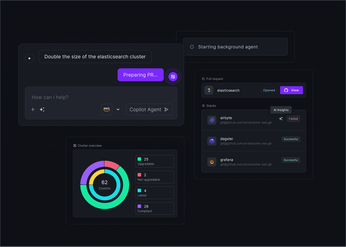
Evaluating the Top 10 Continuous Deployment Tools for Developers
A comprehensive evaluation of Continuous Deployment tools available for developers, Including ArgoCD, Harness, Flux & Plural CD.
In today's fast-paced world, businesses are under immense pressure to deliver high-quality software releases quickly and reliably. Continuous Deployment (CD) is a valuable practice that allows developers to deliver on that promise. The method involves creating a well-defined pathway from code changes to production.
However, implementing Continuous Deployment on your own can be challenging. Writing scripts to manage your deployments can quickly become unwieldy and brittle when managing larger environments. Fortunately, there are tools available that help automate the process, making it easier for developers to release better software with quick turnarounds.
In this blog post, we'll compare some of the leading Continuous Deployment tools available for developers.
ArgoCD
ArgoCD is a popular tool that allows developers to automate the delivery of software to Kubernetes clusters. It works by allowing you to define your applications and their environments as code and then deploy and update them on any Kubernetes cluster. It comes with an array of features such as the ability to deploy applications from Git, manage their lifecycle, and keep your environment in sync. Additionally, ArgoCD provides automated testing and can automate deploying the latest changes to staging and production environments.
Pros and Cons of ArgoCD
Some major pros of using ArgoCD are that it has a user-friendly interface and is open-source with wide adoption.
One notable con to using ArgoCD is that it can require a significant amount of customization to meet specific use cases. ArgoCD was primarily designed for simple single-cluster deployment out of a unique git repository. Simply put, ArgoCD doesn’t fully support monorepo and performance issues start to arise if you have a repository with many (50+) applications. Again, this will likely depend on the resources given to ArgoCD and how often you plan to pull/push, but ArgoCD maintainers discourage using it for deploying apps out of monorepos.
Plural
Plural is an end-to-end solution for managing Kubernetes clusters and application deployment. It offers a managed Cluster API provisioner to consistently set up managed and custom Kubernetes control planes for top infrastructure providers.
Finally, Plural acts as a Single Pane of Glass for managing application deployment across environments by allowing you to see all deployments across clusters - both for open-source applications and those developed in-house.
Pros & Cons of Plural CD
A big pro of utilizing Plural CD is its ability to effortlessly detect deprecated Kubernetes APIs used in your code repositories and helm releases, minimizing the effect deprecated APIs can have on your ecosystem. On top of that, it lets you rapidly create new Kubernetes environments across any cloud without having to wrangle YAML in a single, scalable user interface where your organization can deploy and where your organization can deploy software quickly and monitor your deployments to keep them healthy. A con of Plural CD is that it is not built yet – our team is working hard to get it ready (Update to come soon).
Harness
Harness is a Continuous Deployment platform that automates and orchestrates a wide range of delivery pipelines. It helps developers deploy code more quickly, with more reliability, and with less effort.
Pros and Cons of Harness
Harness is a feature-rich and mature project. One of the biggest differentiators of Harness is the ability to do different deployment strategies such as canary and blue/green deployments. The product also utilizes AI and ML. Their AI Ops feature uses machine learning algorithms to detect anomalies and failures in deployment pipelines. Another advantage of using Harness is its advanced Rollbacks feature, which automatically reverses harmful changes.
A con of Harness is that it can be more expensive than other solutions, largely due to its advanced features that most organizations find to be overkill.
Akuity
Akuity is a fully managed Kubernetes application delivery platform powered by Argo; it's a cloud offering of ArgoCD. Essentially, Akuity allows you to take advantage of Argo CD without maintaining the underlying infrastructure.
Pros and Cons of Akuity
A major pro of using Akuity is it provides a single control plane to manage all applications and environments using one control plane. Developers can also easily update versions across all applications and environments with one click. One significant con of using Akuity is that you are spending money on a managed version of Argo CD (which is open-source), and not using that money on cloud resources. Also, with Akuity you need to already have a Kubernetes cluster up and running to connect to your Argo CD instance, which can be difficult if you are not an expert with Kubernetes.
Armory
Armory CD is an enterprise-grade distribution of Spinnaker that runs in your Kubernetes cluster. Armory CD as a service is a single control plane that allows you to deploy to multiple Kubernetes clusters using our secure agents.
Pros and Cons of using Armory
Developers gravitate towards Armory for its unmatched capability in delivering advanced progressive deployment strategies like blue/green and canary. Its automated canary and impact analysis feature across all deployment stages, gives you a preview of the impact changes will have before going live. Additionally, their platform streamlines cluster deployments by automating constraints and promotions, eliminating error-prone and time-consuming manual steps.
A major con of using Armory is that it does not support deployment to multiple cloud services. Armory cannot also deploy across multiple clusters and environments within one solution vs. several products pieced together that provide a primitive imperative experience and mixed declarative experiences.
Jenkins
Jenkins is one of the most popular open-source automation servers for Continuous Integration and Continuous Delivery. The popular tool was once the standard for CI/CD and has been around since 2004.
Pros and Cons of Jenkins
Jenkins is versatile; it can be used to automate almost anything related to building, testing, and deploying software. Additionally, it has a large plugin ecosystem that makes it easy to extend its functionality.
A drawback is that setting it up and maintaining it can be time-consuming and requires some expertise. Most larger organizations end up dedicating a team to maintaining Jenkins operations.
Spinnaker
Spinnaker was started at Netflix and is an open-source multi-cloud continuous deployment platform that helps you release software changes with high velocity and confidence.
Pros and Cons of Spinnaker
One significant benefit of Spinnaker is its ability to deploy code to multiple cloud environments simultaneously. Additionally, it has several features that are not present in other tools, such as the ability to create pipelines that perform tasks such as blue-green deployments and canaries. However, configuring and maintaining Spinnaker, like Jenkins, can be complicated. On top of that, the tool is not used that much, and many users are advising others to stay clear of Spinnaker and use something else for CD.
Palantir Apollo
Palantir Apollo is an enterprise-grade Continuous Deployment platform that helps you build, deploy, and operate software at scale.
Pros and Cons of Palantir Apollo
One benefit of Palantir Apollo is that it can automate complex workflows and pipelines with ease. Additionally, it comes with pre-built plugins and makes it easy to integrate with other DevOps tools. However, it's a sophisticated platform that can be more challenging to set up and manage.
Palantir Apollo is a mature solution that users gravitate towards due to the fact it can deploy across multiple environments (cloud, on-prem, edge) and in different models (SaaS, private tenant). Apollo is built to manage cross-service dependencies and is a featured-heavy product that comes with constraint-based upgrades, rollbacks, and various deployment strategies.
However, Apollo does have a few cons that users have noted such as it does not support templating like Kustomize or cdk8s. Apollo is also a fairly complex tool for pretty straightforward workflows/learning curves. Also, to use Apollo you must go through an enterprise sales process.
FluxCD
Flux CD is a set of continuous and progressive deployment solutions for Kubernetes that are open and extensible. It helps keep Kubernetes clusters in sync with sources of configuration (like Git repositories) and automates updates to the configuration when there is new code to deploy.
Pros and Cons of FluxCD
Flux CD provides many benefits, such as automated rollouts and rollbacks, automated deployment of images, and automated syncing of Kubernetes resource changes.
A drawback is that it can be complicated to set up initially and is purely a CD solution. Flux is a read-only system that looks at your GitOps repos and makes sure the cluster matches that state. Flux will not run pipelines on your behalf or upload artifacts. Flux will read your artifact registry if it sees a new version it will make a commit to your GitOps repo to update the image version in Kustomization files.
CodeFresh
Codefresh is a complete CI/CD solution, not just CI, covering the full software lifecycle. The cloud-native continuous integration and deployment platform enables teams to quickly and efficiently develop, deploy, and manage cloud-native applications.
Pros and Cons of CodeFresh
CodeFresh is a hosted version of Argo CD so it removes the complexity of maintaining and scaling Argo CD as you grow. However, it still requires users to have some familiarity with Kubernetes and to already have a Kubernetes cluster up and running.
Why Plural makes sense
Continuous Deployment plays a vital role in today's software development landscape, allowing teams to deliver code more efficiently, with more reliability, and with fewer errors. In this blog post, we looked at some of the leading Continuous Deployment tools available for developers.
Over the last few years, we’ve seen that Continuous Deployment on its own isn’t sufficient for fast-moving development teams. Several areas in particular that need to be addressed are:
- Provisioning and managing Kubernetes clusters through their lifecycle is difficult, especially at scale.
- Maintaining a Kubernetes yaml codebase for application development is error-prone and frequently untestable.
- Creating an enterprise-grade deployment pipeline is tricky with existing open-source tooling like Argo-CD or CI tooling like GitHub actions.
To tackle these challenges we built an end-to-end solution for managing Kubernetes clusters and application deployment at scale. Plural serves as a single pane of glass for managing all application deployments.
Plural provides a managed Cluster API provisioner that ensures the consistent setup of either managed or existing Kubernetes control planes across infrastructure providers. With Plural, you also have access to a full deployment pipeline system that gives you the ability to deploy your microservices to those clusters.
If you're finding it challenging to implement Continuous Deployment on your own, consider using Plural. Sign up below for a custom demo on how Plural compares to other solutions on the market.
Newsletter
Join the newsletter to receive the latest updates in your inbox.







